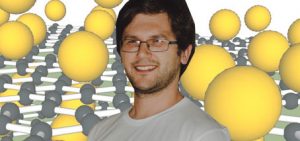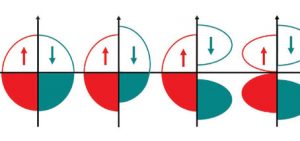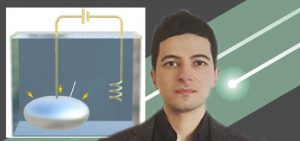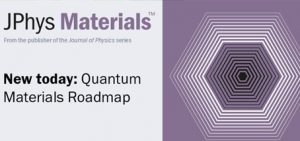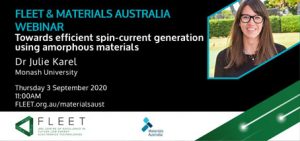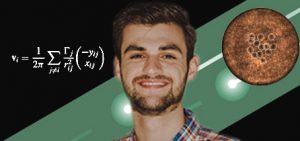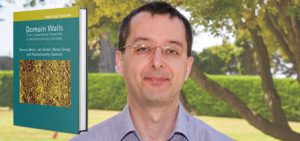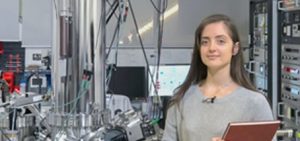Engage
See news from around FLEET, below
Catch up on all past issues of FLEET News newsletter
FLEET News
–by Iolanda Di Bernardo and Hareem Khan WLA’s Leading Edge program is designed to help women in their first leading position to develop their leadership skills, enabling the transition of aspiring and early-career female managers into confident, capable and motivated leaders. Throughout the six-month course participants are presented with topics including elements of a successful team / personal styles interpersonal …
International collaboration reviews future data-storage technology that steps ‘beyond binary’, storing more data than just 0s and 1s Electronic data is being produced at a breath-taking rate. The total amount of data stored in data centres around the globe is of the order of ten zettabytes (a zettabyte is a trillion gigabytes), and we estimate that amount doubles every couple …
Scientists finding creative ways to do science-outreach found a silver lining in COVID restrictions actually improved the experience for students, and took the scientists back to remember ignition of their own childhood ‘science spark’. A team of FLEET PhDs and ECRs at UNSW were able to bridge 2020’s COVID restrictions to safely engage a classroom of students with virtual, but …
It’s certainly been a challenge, maintaining science-outreach efforts in 2020… But a group of a FLEET researchers found a way to showcase their labs at UNSW recently, spotlighting the facilities for prospective students at the university’s virtual open day. Introduction to the undergrad physics labs (Krittika Kumar, Matt Rendell, Yoni Ashlea-Alava and Karina Hudson) Measuring superconducting quantum interference: a third-year …
Congratulations to Sumeet Walia, who was named this morning as a finalist in the prestigious Australia Museum Eureka Prizes – the country’s top science awards. An Associate Professor in the School of Engineering, RMIT University, Sumeet is short-listed for the Eureka Prize for an Emerging Leader in Science. “My research is dedicated towards discovering new phenomena in nanomaterials and creating …
FLEET physicists from Monash University and the University of Queensland are finalists, named today, in the Australian Museum Eureka Prizes – the nation’s top science awards. The Australian Quantum Vortex team provided the first proof of a 70-year-old theory of turbulence. Turbulence is everywhere, but remains one of physics’ great unsolved problems. Turbulence in two-dimensional flow, and the giant vortices …
What causes quasiparticle death? In large systems of interacting particles in quantum mechanics, an intriguing phenomenon often emerges: groups of particles begin to behave like single particles. Physicists refer to such groups of particles as quasiparticles. Understanding the properties of quasiparticles may be key to comprehending, and eventually controlling, technologically important quantum effects like superconductivity and superfluidity. Unfortunately, quasiparticles are …
Adding calcium to graphene creates an extremely-promising superconductor, but where does the calcium go? Adding calcium to a composite graphene-substrate structure creates a high transition-temperature (Tc) superconductor. In a new study, an Australian-led team has for the first time confirmed what actually happens to those calcium atoms: surprising everyone, the calcium goes underneath both the upper graphene sheet and a …
Quantum anomalous Hall effect (QAHE)-materials reviewed Magnetic topological insulators and spin-gapless semiconductors A collaboration across three FLEET nodes has reviewed the fundamental theories underpinning the quantum anomalous Hall effect (QAHE). QAHE is one of the most fascinating and important recent discoveries in condensed-matter physics. It is key to the function of emerging ‘quantum’ materials, which offer potential for ultra-low energy …
Imagine an alien world with oceans of liquid metal. If such a world exists, metallic elements are likely the sources of the dissolved materials and particles in these oceans. Everything would be made of metallic elements, even lifeforms. It may sound like a concept pulled straight out of a science fiction movie, but some basic elements of this fantastical vision …
Quantum materials are exploding in condensed-matter, cold-atom physics, materials science. #explainer The new IOP quantum materials roadmap explores current research, future challenges, technical applications, underlying physics in topological insulators, multiferroics, twisted-‘magic angle’ moiré graphene, superconductors (copper-based and TMD-based), topological semimetals, Majorana states + non-equilibrium phenomena (phew!) Read the roadmap ‘Emergent’ phenomena are key to FLEET’s search for ultra-low energy electronics …
An online audience of almost 90 tuned in this week to hear FLEET CI Dr Julie Karel describing her search for non-volatile memory technologies and associated materials challenges. The talk was co-hosted by FLEET and Materials Australia. Catch up on the talk here Julie described her own work at Monash Department of Material Science and Engineering developing materials that can …
An Australian-led study has provided new insight into the behaviour of rotating superfluids. A defining feature of superfluids is that they exhibit quantised vortices – they can only rotate with one, or two, or another integer amount of rotation. Despite this key difference from classical fluids, where vortices can spin with any strength, many features of the collective dynamics of …
FLEET CI Prof Jan Seidel (UNSW) is co-editor on a new book titled “Domain Walls – From Fundamental Properties to Nanotechnology Concepts” published by Oxford University Press. It is the first to cover the emerging field of ferroelectric domain walls in depth, from underlying nanoscale material properties to prototype and emerging nanoelectronics technology and future research concepts in the area. …
—Written by Dr Iolanda di Bernardo, FLEET/Monash An Australian-led study uses a scanning-tunnelling microscope ‘trick’ to map electronic structure in Na3Bi, seeking an answer to that material’s extremely high electron mobility. In studying the topological Dirac semimetal, the team found that exchange and correlation effects are crucial to electron speed, and therefore mobility, and thus to the use of this …








